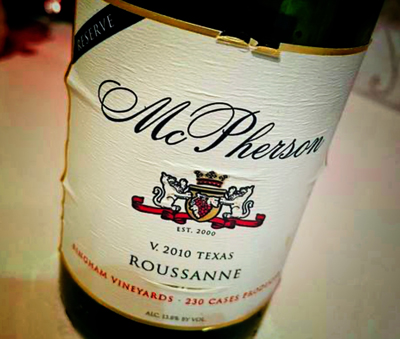
I just realized that I had acquired a decade’s worth of wine made from Roussanne, the acknowledged ageable white wine grape from the Rhone Valley region of France. However, my collection is different; all comes from Texas – vintages 2010, 2012, 2014, 2015, and more, and all produced by Lubbock’s McPherson Cellars.
I figured that now was a good time as any to test my theory that Texas wine drinkers have a special opportunity in their collective grasp – savoring an ageable Texas white wine, Roussanne. Not knowing what I would find, I decided to use my Coravin to break into the wines from two of my oldest vintages – 2010 and 2012.
If you ask people that drink Texas wine, what is Texas’s best white wine, many will undoubtedly say Viognier. Texas Viognier’s fame today is widely acknowledged both inside and outside our state. My claim here is that Roussanne, while a lesser-appreciated white grape in Texas today, it has the ability to provide even better wine characteristics than Viognier, especially when enhanced with bottle age.
McPherson Cellars 2010 Reserve Roussanne
The year 2010 was memorable with its ample winter precipitation, early bud break, minimal freeze issues, and long growing season with a prevalence of moderate temperatures and rainfall, and lots of sun leading up to harvest. This is the year that I traveled “coast-to-coast” in Texas, involved with either book writing or blogging. I remember at the time proclaiming 2010 the Texas “Vintage of the Century” (Click here). So, tasting this wine after a decade brought back special memories.
The color of the McPherson 2010 Reserve Roussanne in the glass was of deep straw, not overly rich in gold or yellow hues. After tasting it, you’d likely call the color that of blanched almonds to go with the nutty-lemon aroma. On the palate this wine was all about balance – good acidity, sufficient but not over-ripened fruit, and a tactile structure of toasted almonds.

McPherson Cellars 2012 Reserve Roussanne
Whereas 2009 was a Spring freeze year, and 2011 was the severe drought , heat, and wildfire year, 2012 more like 2010. It had minimal spring weather issues (freeze or hail), but 2012 was dry and hotter during the growing season than 2010, leading to a considerable riper vintage.
The McPherson 2012 Reserve Roussanne reflected the sun’s intensity that year with its yellow-gold hue. The characteristics of the wine were still nicely balanced with the wine having a more fruit-forward presence on the nose and palate with notes of lemon citrus and white peach and less of the roasted nutty aspects of the 2010 wine. Still, the 2012 Roussanne was respectable after 9 years of bottle aging stacking up just behind the 2010 Roussanne in my rating. However, both wines prove that Texas Roussanne should have a dominant place in Texas wine lexicon.
Texas Viognier vs. Roussanne
After a decade and a half pouring Texas Viognier (our supposed dominant white wine) for Texans (and many outsiders, too), I find that people either love it or they hate it. Hardcore Chardonnay drinkers are the worst. They find Viognier’s floral character a bit too “floral” or “sweet” for them even when it is made near-dry. They also find its rapid ripening tendencies, if not checked, all-to-often leads to high alcohol, heady wines. Consider further that, even before Viognier gets in a wine drinker’s glass, it like Chardonnay and many other white grapes are susceptible to early bud break and demise from our notorious late-Spring freezes.
By comparison, Roussanne, often called a sister-grape to Viognier from the Rhone region, is characterized by bright aromas with nuances of lemon drops, green tea, and roasted almond. In classic white Rhone blends, if Viognier and Roussanne are sisters, Roussanne is usually considered the more refined of the two, and worthy of her moniker – The Queen of Rhone White Grapes. The most age-worthy and most expensive white Rhone blends (think Château de Beaucastel) are dominant in Roussanne, some contain as much as 60 to 80 percent blended with Marsanne and Viognier.
In the vineyard, Roussanne offers an important attraction for Texas winegrowers, too. It typically buds two weeks later than early budding white varieties and is generally slower to ripen. This results in Roussanne’s ability to retain its acidity in the heat of Texas summers. As a result of recent research on bud mortality due to extreme winter cold temperatures like we had this past winter, it’s been found that Roussanne buds were more likely to survive and be viable than many other of Texas’s white grape varieties.
I hope you have a chance to try some Texas Roussanne as we move forward in 2021. I also hope that Texas winegrowers continue their commitment to this fine white grape variety for the betterment of future Texas wines, vintages, and their aging potential. Stop back again to VintageTexas.com again, and I might have tasting notes for Roussanne from the other vintages.

Readers:
Please note that my 2012 notes were a bit sketchy and that I’m going more on memory gains with my travels around the state that year during the release of my book. If any of you have any other recollections of either the 2010 or 2012 vintages, please post your comments below.
One more thing to note is that the McPherson Roussannes were not high alcohol wines – the 2010 and 2010 were both under 14% – which would have helped to retain acidity and also helped ageability.